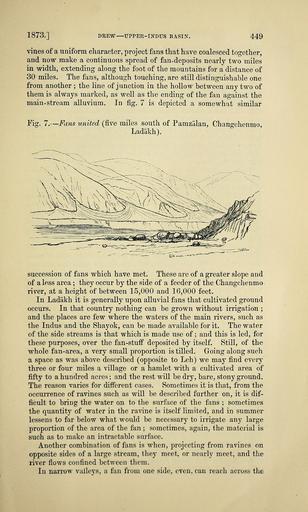MAKE A MEME
View Large Image

| View Original: | The_Quarterly_journal_of_the_Geological_Society_of_London_(13369159353).jpg (1917x3186) | |||
| Download: | Original | Medium | Small | Thumb |
| Courtesy of: | commons.wikimedia.org | More Like This | ||
| Keywords: The Quarterly journal of the Geological Society of London (13369159353).jpg 1873 <br> DREW � UPPER-INDUS BASIN <br> 449 <br> vines of a uniform character project fans that have coalesced together <br> and now make a continuous spread of fan-deposits nearly two miles <br> in width extending along the foot of the mountains for a distance of <br> 30 miles The fans although touching are still distinguishable one <br> from another ; the line of junction in the hollow between any two of <br> them is always marked as well as the ending of the fan against the <br> main- stream alluvium In fig 7 is depicted a somewhat similar <br> Fig 7 � Fans united five miles south of Pamzalan Changchenmo <br> Ladakh <br> succession of fans which have met These are of a greater slope and <br> of a less area ; they occur by the side of a feeder of the Changchenmo <br> river at a height of between 15 000 and 16 000 feet <br> In Ladakh it is generally upon alluvial fans that cultivated ground <br> occurs In that country nothing can be grown without irrigation ; <br> and the places are few where the waters of the main rivers such as <br> the Indus and the Shayok can be made available for it The water <br> of the side streams is that which is made use of ; and this is led for <br> these purposes over the fan-stuff deposited by itself Still of the <br> whole fan-area a very small proportion is tilled Going along such <br> a space as was above described opposite to Leh we may find every <br> three or four miles a village or a hamlet with a cultivated area of <br> fifty to a hundred acres ; and the rest will be dry bare stony ground <br> The reason varies for different cases Sometimes it is that from the <br> occurrence of ravines such as will be described further on it is dif- <br> ficult to bring the water on to the surface of the fans ; sometimes <br> the quantity of water in the ravine is itself limited and in summer <br> lessens to far below what would be necessary to irrigate any large <br> proportion of the area of the fan ; sometimes again the material is <br> such as to make an intractable surface <br> Another combination of fans is when projecting from ravines on <br> opposite sides of a large stream they meet or nearly meet and the <br> river flows confined between them <br> In narrow valleys a fan from one side even can reach across the 39051387 120601 51125 Page 449 Text v 29 http //www biodiversitylibrary org/page/39051387 1873 Geological Society of London Biodiversity Heritage Library The Quarterly journal of the Geological Society of London v 29 1873 Geology Periodicals Smithsonian Libraries bhl page 39051387 dc identifier http //biodiversitylibrary org/page/39051387 smithsonian libraries Information field Flickr posted date ISOdate 2014-03-24 Check categories 2015 August 26 CC-BY-2 0 BioDivLibrary https //flickr com/photos/61021753 N02/13369159353 2015-08-26 10 55 52 cc-by-2 0 PD-old-70-1923 The Quarterly journal of the Geological Society of London 1873 Photos uploaded from Flickr by Fæ using a script | ||||